The University of North Texas announced Tuesday that the school and the Choctaw Nation of Oklahoma are collaborating to develop an Advanced Regional Mobility Corridor designed to offer economic opportunity and growth.Leadership from both sides are collaborating to create a plan for facilitating a multi-modal advanced transportation corridor that will leverage progress with emerging transportation technologies, including automated ground vehicles and advanced air mobility.“UNT is committed to finding solutions for transforming mobility and recently announced plans for an outdoor testing facility — UNT Advanced Air Mobility (UAAM) Test Center — which will significantly increase UNT’s research capacity for unmanned aerial vehicles and other emerging areas of research,” UNT President Neal Smatresk says in a statement. “Our Tier One research university is excited to partner with the Choctaw Nation of Oklahoma to support our region’s economic development, enhance research innovation and expand workforce solutions.”The North Texas region borders the Choctaw Nation of Oklahoma Reservation, which has been active in emerging aviation technology research since 2017, when the tribe was selected as the only tribal government lead participant for the FAA drone Integration Pilot Program and later the FAA UAS BEYOND program.The Choctaw Nation is conducting research to enable “beyond visual line of sight” operations, including delivery of packages by small drones. Choctaw Nation also is developing an Emerging Aviation Technology Center on more than 44,500 acres of tribal-owned land within the Choctaw Nation Reservation and has already built an extensive aviation testing safety infrastructure to support research, development, and testing of emerging aviation technologies.The Choctaw Nation is the third-largest Indian Nation in the United States with more than 200,000 tribal members and 10,000-plus associates. This ancient people have an oral tradition dating more than 13,000 years. The first tribe over the Trail of Tears, its historic reservation boundaries are in the southeast corner of Oklahoma, covering 10,923 square miles.“The future opportunities associated with advanced transportation technologies are exciting and are happening faster than we may realize,” says James L. Grimsley, executive director of Advanced Technology Initiatives with the Choctaw Nation Oklahoma and an Oklahoma Transportation Commissioner. “Future economic growth and even quality of life and quality of health in our communities will be directly impacted by emerging transportation technologies. It is imperative that we begin to responsibly prepare for this future transportation environment.”UNT and the Choctaw Nation have initiated planning for the Advanced Regional Mobility Corridor and will work to formalize concepts and plans in the coming months.





